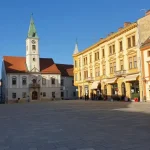We all remember the Black Death. Well, not literally, of course…
If you are from, or grew up anywhere in Europe, you’ll no doubt vividly remember sitting in your school classroom being told disgusting, in depth details of the Black Death, the Black Plague, or whatever your teacher called it.
Hours would be spent in history lessons listening to all of the gory details of the symptoms of the disease for which there was no help, of red letter X’s being painted on people’s front doors to let everyone know that the plague had caught up with them, and that they had dead or dying in the house, unable to be aided by the less than advanced medical science of the time.
The Black Death and the many tales surrounding it are also responsible for the pretty unfair rap brown (yes, brown, not black) rats are still receiving to this very day. Until relatively recently, it was generally accepted and believed that these rats, having been accidentally transported on trade and cargo ships all over the continent, were entirely responsible for the outbreak and the subsequent spread of the devastating disease, mud has well and truly stuck and these small furry creatures, while not exactly ideal to have hanging around in your kitchen, really just want to go about their lives in peace.
In much more recent times, however, the type of fleas that lived on the rats’ fur were believed to have been the main suspects behind the deadly epidemic, and in even more recent times, certain studies have claimed that we humans were actually the ones responsible for wiping out such a huge proportion of, well… ourselves.
Who really ”dunnit”? I guess we’ll never be totally sure. But, let’s take a look at just how the popular Dalmatian destination of Šibenik once suffered, and tremendously so…
As SibenikIN writes on the 8th of June, 2018, the deadly plague began to spread to Šibenik back in the year 1649. The epidemic saw the population of the largest Dalmatian town, which then numbered about 10,000 people, cut to just 1,500, not only devastating human life, but completely changing the city’s developmental course, as sociologist Ivica Poljičak, state secretary at the Ministry of Culture, explains.
”If educated scholars of Šibenik history were asked to choose the toughest moments for Šibenik, I believe that almost all of them would pick the terrible plague of 1649,” writes Poljičak on Facebook.
The Black Death wasn’t the first plague epidemic to have taken its bloody toll on Šibenik, but it was that most terrible disease which changed the face of the city entirely back in the year 1649. In a very ”picturesque” description, Frane Divnić describes the plague in Šibenik, and had its disastrous effects not been properly recorded, the question of just how much would be remembered about it today would be an important one.
Divnić writes that the plague was transferred from the area occupied by the Turks (Ottomans), and the plague was discovered in Šibenik itself on this day, June the 8th, with one older man dying of the horrendous disease first.
Here’s a rough translation of Divnić’s strange and vivid description of those frightening early days of the plague’s arrival in the city:
“Although the doctors didn’t believe he was infected, he was buried without the usual regular attendance of the clergy and the fraternity, owing to the suspicion that the disease had already raised its ugly head. The day after his death, the infection was discovered in several locations across the city, as several houses had things in them that had been stolen from the Turks. It spread even more because of the gathering of the crowds, because the celebration of the Holy Trinity was celebrated on those days, as a fair day in the city; with folk dancing, knight competitions, races, and regattas taking place. It was even more disturbing because of the insanity of a helpless little man who, seeing such mortality, didn’t want to believe it stemmed from the spread of the infection, but claimed that the old dead man had risen from the grave at night and was killing people.”
In 2016, a memorial in memory of the locals who died of the Black Death back in 1649 was raised.







